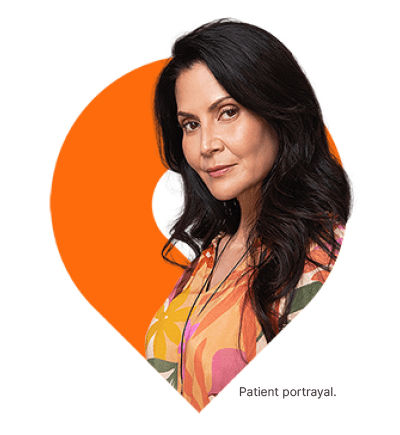
MEET JASMINE: She was recently diagnosed with stage II (T2N1) HR+/HER2- eBC
Find out why KISQALI is right for her.
BACKGROUND
Get to know Jasmine

Jasmine is a 54-year-old dentist and a beloved wife, daughter, sister, and friend. In her free time, she enjoys visiting local food and music fairs.
- During a routine exam, her gynecologist discovered a lump in her left breast and ordered a mammogram
- A biopsy revealed her diagnosis of HR+/HER2- eBC
- After surgery and radiation, she is now in remission
Discover more: download Jasmine's patient profile.
EVALUATION
Jasmine's clinical evaluation
Age | 54 |
Menopausal status | Postmenopausal |
Clinical features |
|
Hormone receptor assay status | ER+/PR+/HER2- |
Gene expression profile assay results | 21 (Oncotype DX® test score) |
ECOG PS | 0 |
Prior therapy | Lumpectomy; adjuvant radiation |
Current therapy | Hormone therapy |
DIAGNOSIS: Stage II (T2N1) HR+/HER2- eBC
RISK OF RECURRENCE
Estimated risk of recurrence for patients with stage II/III HR+/HER2- eBC with N1 disease, grade 1/2, and tumor size <5 cm
5-year risk of recurrence is based on iDFS outcomes from a retrospective cohort study among 437 patients with stage II/III HR+/HER2- eBC with N1 disease with grade 1/2 and tumor size <5 cm, who received adjuvant ET.1
CDK, cyclin-dependent kinase; ET, endocrine therapy; iDFS, invasive disease-free survival.
ANALYSIS
KISQALI + AI consistently reduced the risk of recurrence in the broadest range of patients with stage II/III HR+/HER2- eBC at high risk of recurrence
The iDFS benefit seen in the stage II subgroup was consistent with the overall population
In an exploratory 4-year analysis, at a median follow-up of 44.2 months, reduction in risk of recurrence (iDFS) at the 4-year landmark was 88.5% for KISQALI + AI vs 83.6% for AI alone (absolute difference 4.9%); there was a 28.5% relative reduction in the risk of an iDFS event; HR=0.715 (95% CI: 0.609-0.840).3
Results from the stage II subgroup are exploratory and hypothesis-generating; as such, there was no statistical procedure controlling for type 1 error.
iDFS was defined as the time from randomization to the date of the first event of local invasive breast cancer recurrence, regional invasive recurrence, distant recurrence, contralateral invasive breast cancer, second primary non-breast invasive cancer (excluding basal and squamous cell carcinomas of the skin), or death (any cause).2
NATALEE was a randomized, multicenter, open-label, phase III study of KISQALI + letrozole or anastrozole (n=2549) vs letrozole or anastrozole (n=2552) for the adjuvant treatment of men and women with stage II/III HR+/HER2- eBC, including all those with node-positive or high-risk node-negative disease (eligible stages and nodal status include: anatomic stage group IIB-III, or anatomic stage group IIA that is either node positive, or node negative with histologic grade 3, or histologic grade 2 with Ki-67 ≥20% and/or high risk by gene signature testing). At a median follow-up of 33.3 months, with 509 iDFS (primary end point) events in the study (226 [8.9%] in the KISQALI arm and 283 [11.1%] in the NSAI-alone arm), iDFS at the 3-year landmark was 90.7% for KISQALI + NSAI vs 87.6% for NSAI alone (absolute difference 3.1%); there was a 25.1% relative reduction in the risk of an iDFS event; HR=0.749 (95% CI: 0.628-0.892). At a median follow-up of 47.4 months, iDFS for the prespecified stage II subgroup at the 4-year landmark was 93.9% for KISQALI + NSAI vs 89.6% for NSAI alone; HR=0.644 (95% CI: 0.468-0.887). In an exploratory 4-year analysis, prespecified subgroups included anatomic stage (stage II: HR=0.644 [95% CI: 0.468-0.887]; stage III: HR=0.737 [95% CI: 0.611-0.888]), nodal status (N0: HR=0.666 [95% CI: 0.397-1.118]; N1, N2, N3: HR=0.731 [95% CI: 0.617-0.866]), menopausal status (premenopausal/men: HR=0.677 [95% CI: 0.523-0.877]; postmenopausal: HR=0.760 [95% CI: 0.619-0.933]), and age (<45 years: HR=0.692 [95% CI: 0.489-0.977]; 45 to 54 years: HR=0.716 [95% CI: 0.528-0.972]; 55 to 64 years: HR=0.850 [95% CI: 0.639-1.130]; ≥65 years: HR=0.589 [95% CI: 0.405-0.857]). Results from the subgroup analysis included no prespecified statistical procedure controlling for type 1 error.2-6
KISQALI + AI consistently improved iDFS across subgroups, regardless of stage, nodal status, or menopausal status
KISQALI may be right for a variety of patients with stage II/III HR+/HER2- eBC.
KISQALI—approved for patients like Jasmine who have stage II N1 HR+/HER2- eBC with low genomic risk
See which patient types could benefit from KISQALI.
KISQALI is approved for all patients with stage IIB disease; if stage IIA: all T0N1, all T1N1, and T2N0 if grade 3, or grade 2 with Ki-67 ≥20% or high genomic risk.2,6

